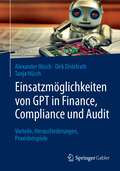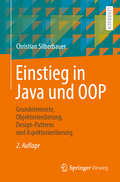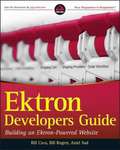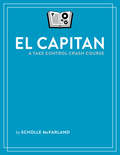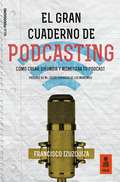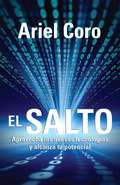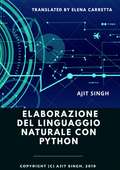- Table View
- List View
Einmal queer gespielt: Über die Rolle der Repräsentation von LGBTQIA+-Identitäten im Videospiel (Über/Strom: Wegweiser durchs digitale Zeitalter)
by Sascha HellerQueere Charaktere in Videospielen? Davon hört man immer öfter! Doch war das schon immer so und wieso brauchen wir das überhaupt? Hier kommen die verschiedenen Perspektiven aus den Queer Studies, Medien-, Sozialpsychologie und der Mediengeschichte zusammen: Dieses Buch führt am praktischen Beispiel einzelner Charaktere ein in die Grundlagen rund um die Konstruktion von Norm, Diskriminierung, queere Identität in Medien und psychologische Modelle zur Mediennutzung. Dadurch lernen die Leser:innen die praktische Relevanz von Repräsentation und die notwendigen Hintergründe kennen.
Einsatz der Blockchain-Technologie im Energiesektor: Grundlagen, Anwendungsgebiete und Konzepte (essentials)
by Alexander Goudz Melisa JasarevicDie Blockchain-Technologie erweist sich als eine neue, hochinteressante Technologie, die seit der Einführung des Bitcoins in zahlreichen Anwendungsfeldern diskutiert wird. Die zahlreichen Forschungsprojekte untermauern die hohen Erwartungen an diese Technologie. Das vorliegende Essential soll ein grundlegendes Verständnis über die Blockchain-Technologie vermitteln und insbesondere den Fokus auf die technologische Ausgestaltung und Konzeptentwicklung in ausgewählten Bereichen der Energiewirtschaft legen.
Einsatz von KI im Unternehmen: IT-Ansätze für Design, DevOps, Governance, Change Management, Blockchain und Quantencomputing
by Eberhard Hechler Martin Oberhofer Thomas SchaeckIhr Unternehmen hat sich für KI entschieden. Glückwunsch, was nun? Dieses praktische Buch bietet einen ganzheitlichen Plan für die Implementierung von KI aus der Perspektive der IT und des IT-Betriebs im Unternehmen. Sie erfahren etwas über die Fähigkeiten, das Potenzial, die Grenzen und die Herausforderungen von KI. In diesem Buch erfahren Sie, welche Rolle KI im Kontext etablierter Bereiche wie Design Thinking und DevOps, Governance und Change Management, Blockchain und Quantum Computing spielt, und diskutieren die Konvergenz von KI in diesen Schlüsselbereichen des Unternehmens.Deploying AI in the Enterprise bietet Anleitungen und Methoden zur effektiven Bereitstellung und Operationalisierung nachhaltiger KI-Lösungen. Sie lernen die Herausforderungen bei der Implementierung kennen, wie z. B. Probleme bei der KI-Operationalisierung und Hindernisse bei der Umsetzung von Erkenntnissen in umsetzbare Prognosen. Sie werden auch lernen, wie Sie die Schlüsselkomponenten der KI-Informationsarchitektur erkennen und welche Rolle sie für eine erfolgreiche und nachhaltige KI-Implementierung spielt. Und Sie werden verstehen, wie Sie KI effektiv einsetzen können, um die Nutzung von Kerninformationen in Master Data Management (MDM)-Lösungen zu verbessern.Was Sie lernen werdenVerstehen der wichtigsten KI-Konzepte, einschließlich maschinelles Lernen und Deep LearningBefolgen von Best Practices und Methoden zur erfolgreichen Bereitstellung und Operationalisierung von KI-LösungenErkennen der kritischen Komponenten der KI-Informationsarchitektur und der Bedeutung eines PlansIntegration von KI in bestehende Initiativen innerhalb einer OrganisationErkennen der aktuellen Grenzen von KI und wie sich dies auf Ihr Unternehmen auswirken könnteBewusstsein für wichtige und aktuelle KI-Forschung schaffenIhre Denkweise anpassen, um KI von einem ganzheitlichen Standpunkt aus zu betrachtenMachen Sie sich mit den Möglichkeiten von KI in verschiedenen Branchen vertraut.Für wen ist dieses Buch gedacht?IT-Profis, Datenwissenschaftler und Architekten, die sich mit den Herausforderungen bei der Implementierung und dem Betrieb von KI auseinandersetzen müssen und einen umfassenden Überblick darüber benötigen, wie sich KI auf andere geschäftskritische Bereiche auswirkt. Es ist keine Einführung, sondern richtet sich an Leser, die nach Beispielen für die Nutzung von Daten suchen, um daraus verwertbare Erkenntnisse und Vorhersagen abzuleiten, und die die aktuellen Risiken und Grenzen von KI verstehen und berücksichtigen müssen und wissen wollen, was dies in einem branchenrelevanten Kontext bedeutet.
Einsatz von KI-gestützter Eignungsdiagnostik in Großunternehmen: Eine Analyse zur Verbesserung der Passgenauigkeit von Neueinstellungen (BestMasters)
by Lisa KeßlerKünstliche Intelligenz (KI) hält zunehmend Einzug in die Personalauswahl großer Unternehmen – mit dem Versprechen höherer Effizienz, besserer Passgenauigkeit und objektiveren Entscheidungen. Doch wie wirkt sich der Einsatz KI-gestützter Verfahren tatsächlich auf die Qualität von Neueinstellungen aus? Lisa Keßler untersucht in diesem Buch das Potenzial und die Grenzen von KI in der Eignungsdiagnostik. Auf Basis qualitativer Experteninterviews mit Fachleuten aus HR und Technologie analysiert die Autorin, wie datenbasierte Systeme die Auswahlprozesse verändern, welche Risiken etwa durch algorithmische Verzerrungen entstehen und wie eine hybride Gestaltung aus menschlicher Intuition und KI-Unterstützung gelingen kann. Die Ergebnisse liefern praxisorientierte Handlungsempfehlungen für Unternehmen und tragen zum wissenschaftlichen Diskurs über den verantwortungsvollen Einsatz von KI in der Arbeitswelt bei.
Einsatzmöglichkeiten von GPT in Finance, Compliance und Audit: Vorteile, Herausforderungen, Praxisbeispiele
by Alexander Hüsch Dirk Distelrath Tanja HüschDieses Buch wurde von drei Experten geschrieben, die mit Unterstützung von GPT, einen umfassenden Einblick in Einsatzmöglichkeiten generativer AI, wie GPT, im Finanzbereich von Unternehmen geben. Es liefert Hintergründe, Vorteile sowie die Herausforderungen und Risiken bei der Implementierung. Es werden neben allgemeinen Anwendungsmöglichkeiten im Unternehmen ebenso spezifische Anwendungen dargestellt. Dabei wird konkret in den Bereichen Controlling, Business Intelligence, Accounting, Investor Relationship, Innenrevision und Kontrollsysteme, Risikomanagement, Wirtschaftsprüfung und Datenschutz eingegangen. Das Buch befasst sich abschließend mit der Strategie im Einsatz von GPT.
Einsatzpotentiale von LoRaWAN in der Energiewirtschaft: Praxisbuch zu Technik, Anwendung und regulatorischen Randbedingungen
by Marcel Linnemann Alexander Sommer Ralf LeufkesLoRAWAN stellte eine kostengünstige Technologie dar, mit der Prozesse innerhalb einer Stadt schnell und einfach vernetzt werden können. Für die Versorgungswirtschaft ergeben sich hieraus enorme potentiale und Geschäftsmodelle. Dieses Buch beschreibt die Technik, die Einsatzfelder, die Potentiale und die regulatorischen Anforderungen, die berücksichtigt werden müssen.
Einsichten eines Informatikers von geringem Verstande: Glossen aus dem Informatik Spektrum
by Reinhard WilhelmEs ist für Fachleute wie Laien immer wieder überraschend, wie die Errungenschaften der Informatik das Leben der Menschen verbessern können, manchmal sogar in Richtungen, welche die Menschen gar nicht unbedingt wünschen. Die aus der Zeitschrift Informatik Spektrum stammenden Glossen in diesem Buch beschreiben kurzweilig und mit viel Humor viele solcher Errungenschaften: Wie sie entstehen, weshalb sie vielleicht doch nicht so groß sind und was noch auf uns zukommt.Eine amüsante Lektüre für Informatiker und ihre gequälten Anwender.
Einstieg in Java und OOP: Grundelemente, Objektorientierung, Design-Patterns und Aspektorientierung (Examen. Press Ser.)
by Christian SilberbauerProgrammieren lernen ist nicht schwer, wenn es richtig erklärt wird. Das Buch bietet eine anschauliche Erläuterung der Grundkonzepte der Programmierung, insbesondere der objektorientierten Programmierung. Alle schwierigen Aspekte werden ausführlich anhand möglichst einfach gehaltener Beispiele erklärt. Vermittelt werden viele Ideen aus der Programmierung wie z. B. Variablen, Funktionen, Rekursion, Datenkapselung oder Vererbung. Empfehlenswert für alle, die die objektorientierte Programmierung von Grund auf lernen und richtig verstehen möchten.
Einstieg in das Influencer Marketing: Grundlagen, Strategien und Erfolgsfaktoren (essentials)
by Marco Nirschl Laurina SteinbergDas vorliegende essential erl#65533;utert die Prinzipien des Influencer Marketing und liefert eine praxisorientierte und komprimierte Einf#65533;hrung in das Thema. Es stellt wirkungsvolle Strategien vor und beantwortet Fragen der Praktiker: Wie kann ich entscheiden, ob sich diese Marketing-Form f#65533;r mein Produkt eignet? Wie w#65533;hle ich die richtigen Kan#65533;le und schlie#65533;lich auch die richtigen Influencer aus? Wie wirkt Influencer Marketing in meinem Marketing-Mix? Klassische Marketing-Kampagnen schaffen es immer weniger, die Wahrnehmungsschwelle der Konsumenten zu durchdringen und somit deren Aufmerksamkeit zu erlangen. Sie schenken der klassischen Werbung immer weniger Vertrauen und holen sich Informationen nach dem Pull-Prinzip. Diese Entwicklung bedient den Trend des Influencer Marketing. Die Autoren geben Anwendungsbeispiele und Entscheidungshilfen.
Einstieg in die Suchmaschinenoptimierung: Grundlagen der Suchmaschinenoptimierung (SEO) verständlich erklärt (essentials)
by Mark HindererBekommen Sie einen grundlegenden, aber umfassenden Überblick über die Arbeitsweise von Suchmaschinen und wie sie Inhalte von Websites auslesen und bewerten. Lernen Sie Möglichkeiten zur Optimierung der eigenen Website kennen und steigern Sie so die Besuchszahlen Ihrer Website. Wie optimiert man die eigene Website, um das Potenzial der Suchmaschinenoptimierung (SEO) auszuschöpfen und die Erwartungshaltung hinter der Suchanfrage so zu erfüllen, dass ein positives Nutzungserlebnis geschaffen wird? Welche Faktoren einer Website können zu einem Rankingverlust führen und sollten vermieden werden, um nicht dem Wettbewerb die bessere Position in den Suchergebnissen zu überlassen?
Ektron Developer's Guide
by Bill Rogers Bill Cava Aniel SudThe first book to cover the Ektron content management system (CMS) Ektron CMS400. NET provides a complete platform that features all the functionality needed to create, deploy, and manage your Web site. The power is in your hands when you use the built-in server controls to deploy a site or customize the deployment with the API. Authored by a trio of Ektron insiders, this book escorts you through the detailed steps of building a prototype company site. Upon completion, you will have a complete and functional coded Web site that you can use as a template for future projects. Introduces the Ektron CMS400. NET as well as the Ektron architecture and includes an in-depth explanation of the Ektron framework Assumes no prior knowledge of the Ektron platform Shows you how to install the CMS, software dependencies, and samples sites Explains how to implement a social network and construct a storefront Ektron Users Guide provides you with everything you need to know about the exciting possibilities of working with this popular and powerful platform.
El Bitcoin y su poder: Todo lo que necesita saber sobre emplear el poder del Bitcoin
by Jerry RyderEl Bitcoin se está apoderando del mundo. Esta moneda digital es completamente diferente a todo lo que haya visto en el pasado, lo que la hace novedosa y excitante. También tiene varios beneficios, como ser: La capacidad de poder enviar dinero a cualquier parte del mundo con bajas tasas por transacción Mantener su información personal segura y protegida No tener que lidiar con la intervención del gobierno Ahora es el momento de empezar con el Bitcoin, el juego de la criptomoneda. Todos saben que el conocimiento es poder. En este libro aprenderá sobre: Que es el Bitcoin realmente Todos los modos en que puede usar el Bitcoin para beneficio personal Cómo comenzar La tecnología atrás del Bitcoin Lo que la moneda digital puede hacer por usted Pros y contras de utilizar monedas digitales Mejores estrategias de inversión Cómo hacer dinero con el Bitcoin Y ¡mucho más! ¡No espere más! Haga click en el botón de comprar ahora y obtenga “Bitcoin y su poder” hoy mismo, y ¡comience a obtener dinero!
El Capitan: A Take Control Crash Course
by Scholle McfarlandAscend El Capitan with Mac expert Scholle McFarland!In this crash course about OS X 10.11 El Capitan, former Macworld editor Scholle McFarland helps you discover and master changes in the Finder as well as in Apple's Notes, Safari, and Messages apps. The book's browsable layout makes it easy for you to find the information that you care about the most as you learn how to set up notifications sensibly, do more (or less) with your Dock, invoke Mission Control and set up a Split View, take phone calls on your Mac, locate all manner of things with Spotlight search, work fluidly between Apple devices with Handoff and AirDrop, dictate to your Mac -- and even tell it what to do -- plus lots more.Scholle closes with two under-the-hood topics, setting up a user account (for a child, guest, or troubleshooting) and essential troubleshooting techniques.Whether you want to browse for a few tips or go deep, you'll learn about...Four techniques for invoking Mission Control, with its new Spaces BarThe new Split View, which puts two apps side-by-side in an elegant wayHow pinned tabs in Safari work differently -- and in some cases better -- than bookmarksThe keyboard shortcut for auto-filling your personal information into a Safari formFinding the new checkbox for auto-hiding the menu barHow you can delete a file without emptying the entire Trash (finally!)What to do if you can't stand OS X's translucent menu bars and windowsHow to keep your Spotlight searches privateThe necessary settings for Handoff to work between devicesSetting up the Mac's Notification Center so it's usefulUsing the Attachment Browser in El Capitan's new Notes appDeciding whether to use plain or enhanced dictationMaking your Mac announce incoming alert notifications with a custom voiceSetting up smart folders that bring tagged files into view easilyEssential tips for decreasing Finder window overload with tabsMany picky details about AirDrop file transfer -- and ideas for alternativesSetting up an account for a child with parental controls and age-based limitsWhat to do if your Mac won't turn on, if you get the spinning beachball of death, or if you need to repair your disk -- and how to easily find out if your Mac still has AppleCareAs part of our Crash Course series, this book will provide the first-rate content you expect from us in short chunks so you can dip in and read quickly. Because so many Take Control readers give tech support to others, each concise chapter has sharing buttons and practical tweet-tips, making it easy to share a few pages with Facebook friends, Twitter followers, and others who really need the information. Crash Courses have a modern, magazine-like layout in PDF while retaining a reflowable design in the EPUB and Mobipocket versions.
El Gran Cuaderno de Podcasting: Cómo crear, difundir y monetizar tu podcast
by Francisco IzuzquizaEl Gran Cuaderno de Podcasting muestra todo lo necesario para aprender a crear un podcast, publicarlo y darlo a conocer para convertirse en un podcaster profesional. Francisco Izuzquiza, locutor y consultor de radio y podcasts, describe las claves y las herramientas imprescindibles para iniciarnos en el mundo de los podcasts y los consejos y aspectos técnicos para usuarios más avanzados o, incluso, expertos. Desde la elección del tema del podcast, su planificación, los métodos de grabación o el micrófono más recomendable según nuestras necesidades y presupuesto, a los programas de grabación, el alojamiento del podcast, la medición de escuchas, los rankings, la música, los derechos de autor y la monetización. El auge de los podcasts supone un reto apasionante para todo aquel que quiere acercase a esta actividad desde el mundo de la radio o desde cualquier otro sector. En este libro el autor comparte su experiencia y todo lo aprendido hasta conseguir dedicarse al podcasting de forma profesional.
El choque inevitable: Prensa, discurso y poder en el sexenio de López Obrador
by Raúl Cortés¿Por qué López Obrador se ha obsesionado con los medios (sobre todo con los "conservadores"), a quienes considera sus más fieros contrincantes? ¿Por qué miente y desinforma con tanta confianza incluso cuando se le presentan evidencias que anulan sus afirmaciones? ¿Qué consecuencias políticas tiene su actitud retadora y desdeñosa hacia la verdad y los hechos? Sea como un recurso para polarizar al país en su beneficio o como una genuina estrategia de cambio, el presidente de México ha logrado convertir la relación entre el poder y los medios de comunicación en uno de los aspectos centrales de su gestión. Esto ha generado confrontación, pero también dependencia, y ha marcado el ritmo de la discusión pública en México desde que el presidente estableció las conferencias "mañaneras" como la principal vía de comunicación de su gobierno. Este libro registra y analiza esa interdependencia. Mitad crónica de los primeros cuatro años de gobierno de AMLO, centrada en los bulos que se han lanzado día tras día desde el púlpito del presidente, y mitad ensayo sobre el uso político de las fake news y el papel de la ética periodística en un mundo dominado por la desinformación y la infodemia, es uno de los textos que mejor documentan un fenómeno tan complejo como preocupante: las implicaciones políticas de la posverdad.
El enemigo conoce el sistema: Manipulación de ideas, personas e influencias después de la economía de la atención
by Marta PeiranoTodo lo que no quieres pero necesitas saber sobre el poder, la economía, la sociedad y las telecomunicaciones en la era de la información. La red no es libre, ni abierta ni democrática. Es un conjunto de servidores, conmutadores, satélites, antenas, routers y cables de fibra óptica controlados por un número cada vez más pequeño de empresas. Es un lenguaje y una burocracia de protocolos que hacen que las máquinas hablen, normas de circulación que conducen el tráfico, microdecisiones que definen su eficiencia. Si la consideramos un único proyecto llamado internet, podemos decir que es la infraestructura más grande jamás construida, y el sistema que define todos los aspectos de nuestra sociedad. Y sin embargo es secreta. Su tecnología está oculta, enterrada, sumergida o camuflada; sus algoritmos son opacos; sus microdecisiones son irrastreables. Los centros de datos que almacenan y procesan la información están ocultos y protegidos por armas, criptografía, propiedad intelectual y alambre de espino. La infraestructura crítica de nuestro tiempo está fuera de nuestra vista. No podemos comprender la lógica, la intención y el objetivo de lo que no vemos. Todas las conversaciones que tenemos sobre esa infraestructura son en realidad conversaciones sobre su interfaz, un conjunto de metáforas que se interpone entre nosotros y el sistema. Un lenguaje diseñado, no para facilitar nuestra comprensión de esa infraestructura, sino para ofuscarla. El enemigo conoce el sistema pero nosotros no. Este libro te ayudará a conocerlo, y a comprender por qué la herramienta más democratizadora de la historia se ha convertido en una máquina de vigilancia y manipulación de masas al servicio de regímenes autoritarios. Solo así podremos convertirla en lo que más falta nos hace: una herramienta para gestionar la crisis que se avecina de la manera más humana posible. No tenemos un segundo que perder.
El futuro es ahora: Un viaje a través de la realidad virtual
by Jaron LanierEl padre de la realidad virtual nos explica sus infinitas posibilidades a través de su experiencia con la tecnología. A través del fascinante recorrido de una vida dedicada a la tecnología, Jaron Lanier expone la capacidad de la realidad virtual para iluminar y amplificar la comprensión que tenemos de nuestra especie y ofrece a los lectores una nueva perspectiva sobre cómo el cerebro y el cuerpo humano se conectan al mundo. Al entender la realidad virtual como una aventura tanto científica como cultural, Lanier demuestra el componente humanístico que esta aporta a la tecnología. Si bien sus libros anteriores ofrecían una visión más crítica de las redes sociales y de otras manifestaciones de la tecnología, en El futuro es ahora el autor argumenta que la realidad virtual puede hacer que nuestra vida sea más rica y más completa. Una obra que no solo nos muestra qué significa ser humano en esta era de posibilidades tecnológicas sin precedentes, sino que también une la dimensión tecnológica con nuestra experiencia corporal. Reseñas:«Una historia maravillosa, profundamente humana y sumamente personal.»Dave Eggers «Es el padre de la realidad virtual y un genio de la tecnología punta.»Sunday Times «Una mente tan ilimitada como internet.»Evening Standard «Íntimo e idiosincrásico [...] peculiar y fascinante [...] La vívida imaginación de Lanier se convierte en un personaje más. Su visión es humanista e insiste en que el objetivo más importante del desarrollo de la realidad virtual debe ser la conexión humana.»The New York Times Book Review «Una lectura esencial, no solo para los conocedores de la realidad virtual, sino para cualquiera interesado en comprender cómo la sociedad ha llegado a convertirse en lo que es hoy en día y en qué podría convertirse en un futuro no tan lejano.»The Economist «Brillante e inspirador.»Publishers Weekly
El gran cambio: Cómo desarrollar un emprendimiento exitoso en la era digital. El caso kambista
by Franco Lanata ZeladaConoce la historia de Kambista, la primera casa de cambio digital en el Perú Esta es la historia de un emprendimiento disruptivo. El modo como un grupo de amigos ideó Kambista: la primera casa de cambio digital en el Perú. El relato fresco de Franco Lanata, acompañado de los útiles comentarios de Daniel Bonifaz —socio fundador de Kambista—, da cuenta del desarrollo de este proyecto innovador y exitoso que supo resolver una necesidad en el campo de las transacciones monetarias en el país: cómo cambiar dinero de manera justa, segura y transparente mediante la vía digital. Aquí se cuenta el origen de la empresa, los errores, los aciertos, los desafíos, la consolidación del plan, las campañas comunicativas y, lo que es más resaltante, el trabajo en equipo de unos jóvenes que no solo supieron echar a andar su sueño, sino aportar un beneficio a la economía de todos los peruanos. El gran cambio se propone compartir los aprendizajes obtenidos a partirde la hazaña de Kambista, con el fin de que esta experiencia sirva de ayuda a futuros emprendedores.
El internet: Diferentes maneras de convertirse en parte de la comunidad (¿Cómo...? #79)
by Owen JonesEspero encuentre información rentable, de utilidad y de ayuda. Las ideas de este libro electrónico sobre diversos aspectos de Internet, incluido su uso en beneficio propio, están organizadas en 17 capítulos de entre 500 y 600 palabras cada uno. Espero que sea de interés para quienes esperan ganar dinero en línea y para quienes desean atraer más tráfico a un negocio fuera de la red mediante el empleo de los recursos a menudo “gratuitos” que ofrece Internet. También será útil para los blogueros que solo quieren hacer amigos al rededor del mundo y chatear con ellos. Afortunadamente, muchos aspectos de Internet siguen siendo gratuitos, especialmente si no se deja manipular por los autoproclamados gurús de Internet, que están esperando para abalanzarse sobre los novatos desprevenidos. Como beneficio adicional, yo mismo le autorizo para usar el contenido en su propio sitio web o en sus propios blogs y boletines, aunque es mejor si primero los vuelve a escribir con sus propias palabras.
El modelo para ganar dinero de ChatGPT para emprendedores: Descubra los secretos para monetizar ChatGPT y obtener ingresos masivos
by John AlexanderEn la vertiginosa era digital, la clave del éxito reside en adoptar tecnologías de vanguardia. Prepárese para liberar el potencial del lenguaje y la inteligencia artificial con "Ganar dinero con Chat GPT". Esta guía indispensable le lleva en un viaje cautivador, revelando los secretos para aprovechar Chat GPT, el modelo de lenguaje avanzado de OpenAI, para la máxima generación de ingresos. Descubra su camino hacia los beneficios: Entre en el lucrativo mundo del trabajo autónomo y potencie sus habilidades con la destreza lingüística de Chat GPT. Destaque en el abarrotado mercado, presentando ofertas en proyectos que muestren su experiencia mejorada por la IA. Sea testigo de cómo sus ingresos se disparan a medida que se convierte en el experto al que acudir, ofreciendo resultados de primera categoría con el poder de la IA al alcance de su mano. Cree Chatbots irresistibles para el éxito: Revolucione la forma en que las empresas interactúan con los clientes mediante la creación de chatbots inteligentes. Vea cómo la automatización de la atención al cliente alcanza nuevas cotas a medida que Chat GPT proporciona respuestas rápidas y precisas. Genere confianza, gane lealtad y aumente los ingresos a medida que sus clientes experimentan una satisfacción sin precedentes. Libere su potencial de escritura: Eleve su juego de creación de contenido con Chat GPT como su asistente de escritura. Experimente la magia de generar entradas de blog convincentes, artículos cautivadores y descripciones de productos persuasivas. Atraiga a su audiencia como nunca antes, generando tráfico y conversiones mientras ahorra tiempo y esfuerzo. Conquiste el marketing en redes sociales: Llame la atención en las redes sociales con la delicadeza de Chat GPT. Lance exitosas campañas publicitarias, domine las publicaciones atractivas y cultive un seguimiento masivo. Vea cómo el alcance de su marca se expan
El muro digital: Acciones disruptivas para impulsar a México
by Luis FerezinUn llamado a la acción por parte del gobierno, las empresas, los innovadores, los consumidores y, sobre todo, los ciudadanos para derrumbar esa muralla que hemos construido en contra de una economía digital, desperdiciando recursos, eficacia, progreso y crecimiento. Con gran talento, conocimiento y visión, Luiz Ferezin muestra cómo el "muro digital" ve al futuro del siglo XXI, mientras que el "muro fronterizo" nos regresaría al siglo pasado. Con una narrativa clara y contundente, Ferezin explica cómo la transformación digital está redefiniendo la conducta y operación de las empresas. Recomienda, por tanto, que éstas se incorporen de lleno a la revolución tecnológica para minimizar los efectos negativos de los muros físicos y del proteccionismo. Es un libro que hay que leer. - JAIME SERRA PUCHE Exsecretario de Comercio y Fomento Industrial y exsecretario de Hacienda y Crédito Público. Nos encontramos frente a un auténtico muro cuando no hacemos el máximo uso de la digitalización para impulsar la productividad y crecimiento de México. Un claro llamado a la acción nos propone Luiz Ferezin, para sustituir cada ladrillo por una experiencia digital que impulse el dinamismo del mercado de manera eficiente y efectiva. Está en cada uno de nosotros eliminar estos límites. -PEDRO PADIERNA Presidente del Consejo de PepsiCo México Accenture es una firma global líder en servicios profesionales que ofrece una amplia gama de servicios y soluciones en las áreas de estrategia, consultoría, digital, tecnología y operaciones. Combinando su gran experiencia y conocimientos especializados en más de cuarenta industrias y en todas las áreas de negocio -respaldada por la red de centros de desarrollo más grande del mundo-, Accenture trabaja en la intersección del negocio y la tecnología con el objetivo de ayudar a sus clientes a mejorar su rendimiento y crear un valor sostenible para sus accionistas. Con más de 425,000 profesionales trabajando en más de 120 países, Accenture impulsa la innovación para mejorar la forma en la que el mundo vive y trabaja. Para saber más, visítanos en www.accenture.com
El reto de ser Youtuber (#TeamNico #Volumen)
by Nicolás SeguraDescubre todos los secretos de Nico, el gamer infantil más popular de YouTube En su nuevo libro, Nico se sincera con todos sus fans y seguidores para explicar, con las bromas y los memes más locos, los secretos de su canal, su historia personal, cómo es su día a día como estrella de YouTube, cómo hace sus vídeos, cuáles son sus juegos favoritos y sus mejores trucos, y las anécdotas más épicas en sus seis años frente a las cámaras.
El salto
by Ariel CoroPuedes tratar de ignorarla pero es inevitable. La tecnología está transformando tu vida y el mundo que te rodea a una velocidad prácticamente incomprensible. Las reglas del juego han cambiado: desde como buscar un trabajo, educarte, promover o financiar tu negocio y hasta proteger a tu familia. Para ser exitosos, es imperativo entender cómo aprovechar estas nuevas herramientas a tu favor. En este revelador libro, Ariel Coro, el principal experto de tecnología para la comunidad hispana, te ofrece justamente eso: un pasaje a este nuevo mundo que te ayudará a lograr tus metas y alcanzar tus sueños. El salto es un manual de supervivencia para los tiempos que estamos viviendo. Ofreciendo útiles ejemplos y recursos gratuitos, Coro te mostrará cómo sacar el máximo provecho de este nuevo mundo para encontrar una ruta más directa y rápida hacia el éxito. No te quedes atrás. Conéctate y atrévete a dar "el salto" hacia un brillante y exitoso futuro.
El salto: Aprovecha Las Nuevas Tecnologías Y Alcanza Tu Potencial
by Ariel CoroPuedes tratar de ignorarla pero es inevitable. La tecnología está transformando tu vida y el mundo que te rodea a una velocidad prácticamente incomprensible. Las reglas del juego han cambiado: desde como buscar un trabajo, educarte, promover o financiar tu negocio y hasta proteger a tu familia. Para ser exitosos, es imperativo entender cómo aprovechar estas nuevas herramientas a tu favor. En este revelador libro, Ariel Coro, el principal experto de tecnología para la comunidad hispana, te ofrece justamente eso: un pasaje a este nuevo mundo que te ayudará a lograr tus metas y alcanzar tus sueños. El salto es un manual de supervivencia para los tiempos que estamos viviendo. Ofreciendo útiles ejemplos y recursos gratuitos, Coro te mostrará cómo sacar el máximo provecho de este nuevo mundo para encontrar una ruta más directa y rápida hacia el éxito. No te quedes atrás. Conéctate y atrévete a dar el salto hacia un brillante y exitoso futuro.
Elaborazione del linguaggio naturale con Python
by Ajit SinghLa PNL è un settore ampio e multidisciplinare, quindi questo libro può fornire solo un'introduzione molto generale. Il primo capitolo ha lo scopo di fornire una panoramica delle principali sottoaree e una brevissima idea delle principali applicazioni e delle metodologie utilizzate. La storia della PNL viene brevemente discussa come un modo per metterla in prospettiva. I tre capitoli successivi descrivono in modo più dettagliato alcune delle principali sottoaree. L'organizzazione si basa su una maggiore "profondità" di elaborazione, a partire da tecniche relativamente orientate alla superficie e passando a considerare il significato delle frasi e il significato delle parole nel contesto. Ogni capitolo prenderà in considerazione la sottoarea nel suo insieme per poi passare a descrivere uno o più algoritmi campione che affrontano problemi particolari. Gli algoritmi sono stati scelti perché sono relativamente semplici da descrivere e perché illustrano una tecnica specifica che si è dimostrata utile, ma l'idea è quella di esemplificare un approccio, non di fornire un'indagine dettagliata (cosa che sarebbe impossibile nel tempo a disposizione). Tuttavia, altri approcci saranno talvolta discussi brevemente. Il capitolo finale riunisce il materiale precedente per descrivere lo stato dell'arte nelle applicazioni campione. Obiettivi: L'obiettivo del mio libro per gli studenti è quello di: 1. essere in grado di descrivere l'architettura e il design di base di un sistema generico di PNLP "shell". 2. essere in grado di discutere le prestazioni attuali e future di diverse applicazioni della PNL, come la traduzione automatica e la risposta via e-mail. 3. essere in grado di descrivere brevemente una tecnica fondamentale per l'elaborazione del linguaggio per diverse sottoattività, come l'analisi morfologica, l'analisi sintattica, la disambiguazione del senso della parola, ecc. ●4. Capire come queste tecniche si ispirano e si relazionano ad altre aree dell'informatica (




